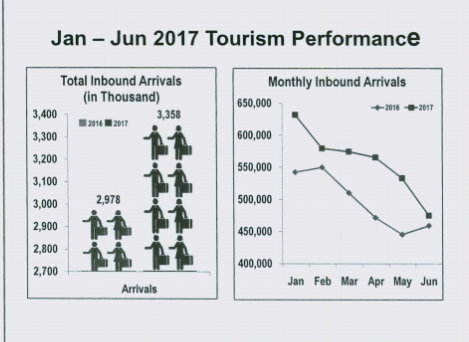
The Department of Tourism tells the House appropriations committee that tourist arrivals increased year-on-year to 3.36 million for January to June 2017, compared to the 2.97 million logged for the same period in 2016. IMAGE FROM THE DEPARTMENT OF TOURISM
The Department of Tourism (DOT) has defended the proposed 333-percent hike of the budget of its branding campaign program to P1 billion—including P250 million for “global influencers”—as the country’s marketing funding has paled compared with its Asian neighbors.
This comes as Tourism Secretary Wanda Corazon Tulfo-Teo admitted during the House of Representatives appropriations committee hearing on Wednesday that martial law in Mindanao should no longer be extended.
“I hope the President (Rodrigo Duterte) would lift martial law by the end of the year,” she said after Northern Samar 1st Dist. Rep. Raul Daza of the opposition bloc inquired about the effect of martial law in Mindanao to the tourism industry.
Without elaborating on statistics—which the regional offices have yet to submit—Teo acknowledged that because of martial law in Mindanao, “there were cancellations but we’re doing our best.”
Later on, she explained: “We invite travel operators, media bloggers, influencers to come to the Philippines to see we’re safe.”
ACT Teachers Party-list Rep. France Castro questioned why the lump-sum allocation for the country’s branding program received a proposed three-fold boost.
Tourism Undersecretary Katherine de Castro explained the proposed increase would be spent as follows: P100 million for global media placements, P300 million for brand development including strategic placements, P50 million for a media study, and P250 million for “global influencers.”
Sought for clarification, Tourism Assistant Secretary Frederick Alegre told reporters that “influencers” refer to social media bloggers who promote the country especially on image-sharing site Instagram.
Teo during the hearing defended the allocated cost as the Philippines has a “very low budget” of US$6 million (roughly P300 million), even as the agency continued to “meet our targets.”
She compared the Philippine marketing budget to those of Indonesia at $127 million, Hong Kong at $66.4 million, India at $64 million, Malaysia at $36 million, Thailand at $23 million, and Singapore at $15 million.
Even as Teo acknowledged the impact of martial law, she touted the year-on-year increase in tourist arrivals to 3.36 million for January to June 2017 from 2.98 million for the same period in 2016.
A monthly breakdown was not discussed in the hearing, but the line graph showed that May and June 2017 figures of 550,000 and roughly 470,000 were higher than those for the same months in 2016 at the 450,000 level. However, arrivals dropped month-on-month from May to June 2017, when the trend in 2016 was for it to increase.
The DOT could not provide a breakdown of tourist arrivals by region either, when asked by Lanao del Norte 1st Dist. Rep. Mohamad Khalid Dimaporo for statistics on the Marawi City conflict’s effect on tourism in the rest of Mindanao.
Tourism Undersecretary Benito Bengson Jr. tried to compare yearly regional figures for the years 2015 and 2016, but Dimaporo pointed out that it would not help.
“This is a blatant evidence that DOT is not monitoring the tourist arrivals… and the impact that martial law has in the region of Mindanao!” Dimaporo said. “That’s a simple question which cannot be answered by our secretary, and her team cannot answer.”
“I suppose I would be honest to tell you of course our region was affected,” Teo admitted. JPV

